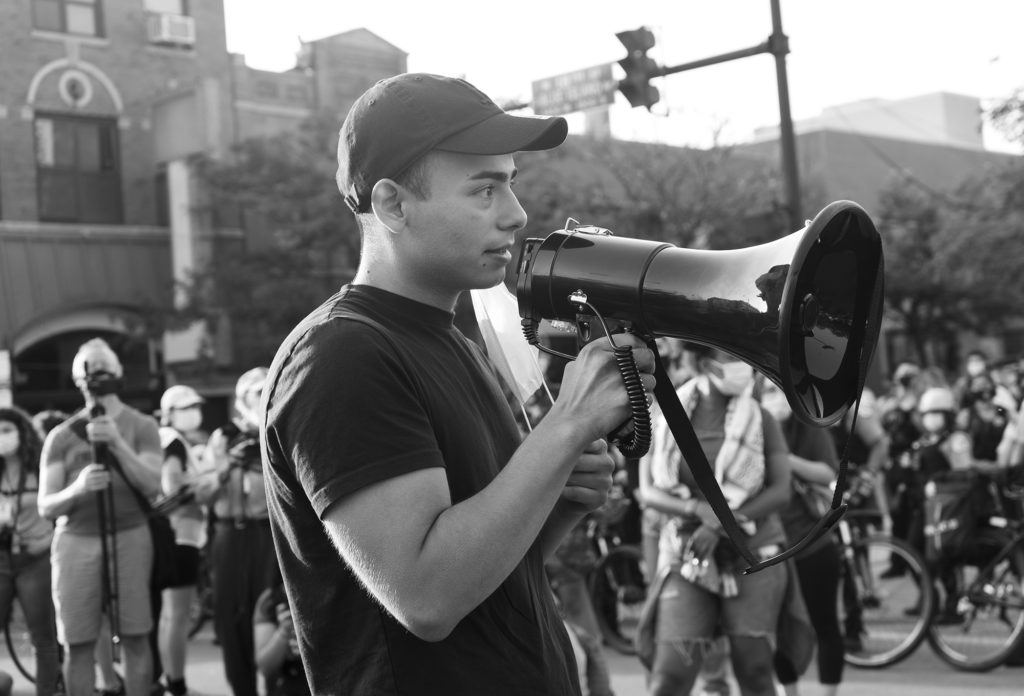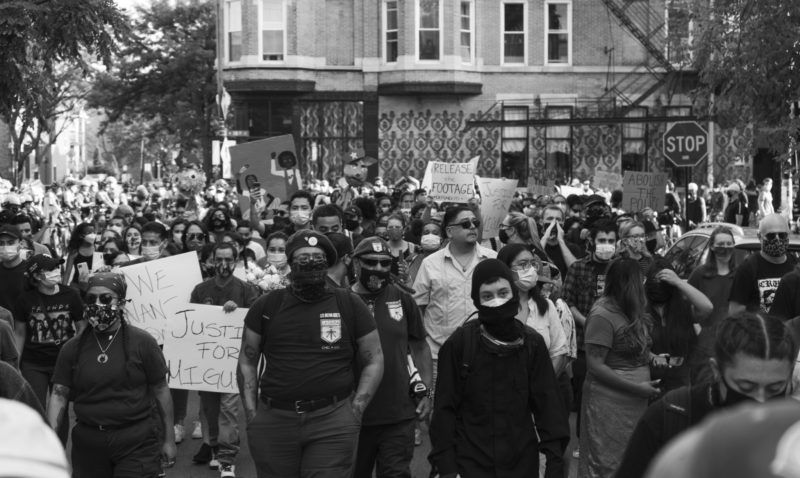Have you seen bloodstains on a sidewalk? An empty plastic bottle of bleach to hold flowers for someone that was killed? An entire block riddled with bullet holes? These are all scenes I witnessed way too often growing up in Pilsen. This was also the scene at 19th and Throop a day after an undercover police officer killed an unarmed man, Miguel Vega, by shooting him in the back of his head.
Miguel was a twenty-six-year-old father, brother, and son, whose family says he wasn’t a gang member. But he grew up around people that were in a gang. “I put myself in my son’s shoes, I did the same thing. Some of my friends were in gangs,” said his father Miguel Vega Sr. “After school, I hung out with my friends. After work, I hung out with my friends. I never claimed to be in a gang but some of my friends were involved in that life. It’s a part of your barrio. Your friends are like your family.”
His son was gang-affiliated by association, due to his childhood friendships, yet he didn’t have a single placa [tattoo] or criminal record to show for it.
This happened to a lot of us growing up in Chicago. I grew up around a lot of gang-affiliated people too. If you lived on a certain block or one of your friends was in a gang, you had to deal with the possibility of being mistaken by rivals or police for belonging to a gang. As children and youth who grow up witnessing gun violence, police brutality, and constant threats, we’ve never had the space to address our personal problems and post-traumatic stress in healthy ways.
Pilsen is the neighborhood with the most rival gangs I’ve ever seen. Within one and a half miles, the Ambrose, Bishops, Latin Counts, Party People, La Raza, and the Satan Disciples have all had an ongoing conflict for more than thirty years. That’s not counting the smaller crews like the Allport Lovers, Racine Boys, Cullerton Boys, and Wolcott Boys, which never had aspirations of becoming fully structured gangs, but took up arms, claiming blocks out of a need to feel protected and to avoid being pressured into joining the larger gangs.
These gangs originated as a means to keep unsupervised youth safe while their parents worked, and to concoct a bicultural immigrant and American identity. Due to the lack of extracurricular activities and under-resourced public schools, on top of over-policing, most gangs have lost their original purpose. Most recently, the massive wave of gentrification has destabilized and displaced Pilsen’s youth. Ironically, people tend to associate a neighborhood getting gentrified with it becoming safer and clearly that’s not the case in Pilsen right now.
You might begin to ask yourself how so many gangs mobilized freely in Pilsen for decades. Our former alderman, Danny Solis, did not address the lack of academic and recreational resources, which lead youth to have nothing better to do but to join gangs. The former alderman was involved in pay-to-play politics and soliciting prostitution in the North Side, but this is Chicago, so he’s freely walking the streets and currently receiving an annual $94,000 pension paid by our tax money. In fact, Solis has more of a criminal record than Miguel Vega ever had, and nobody suggests that he should be shot. While Solis was collecting developer money, a lot of kids in his ward grew up like Miguel Vega, including me. If you grew up in the streets around here, you know the ins and outs. Some people can tell you the starting five players on the Bulls or the name of every song that plays on a top forty radio station. I can tell you the name of every single corner store and taquería in my neighborhood.
I got a call Tuesday morning, September 1, about an undercover police officer killing a man in my neighborhood and immediately went to the scene. I photographed the bullet holes, bloodstained concrete, red tape, shattered windows, and La Virgen painted on a wall of a building next to the alley. Miguel Vega’s little brother Erik was standing on the sidewalk speaking to reporters. You could see his pain, but he was standing tall, telling reporters his brother was unarmed and murdered by an undercover police officer.
An unsettling flashback hit me as I was holding my camera. About nineteen years ago, almost a lifetime, police carried themselves in a similar reckless paramilitary-like manner. Officer Brian T. Strouse was an undercover police officer who antagonized a group of Ambrose gang members who were hanging out in an alley near 18th Place and Throop—a block away from where Vega was shot. In plain clothes, Strouse threw up a gang sign at the group and was immediately shot dead by a member of the Ambrose gang who thought he was a La Raza member. Hector Delgado, age sixteen, was arrested and sentenced to life in prison.
Thirty years later, several media outlets have regurgitated the police account that Miguel shot at them and they returned fire. The Chicago Police Department did not initially state the officers were undercover. We know CPD has a tendency of rushing to justify police shootings, but it has remained suspiciously silent about this case and has not released any body-cam footage or the name of the undercover officer who killed Miguel Vega.
Eyewitnesses claim that an unmarked car had been parked on the corner of 19th Street and Loomis for about twenty minutes before 911 calls were allegedly made about suspicious activity in the area. Around 10:30pm, the car, with two undercover police officers, peeled out without sirens or flashing lights, accelerating east on 19th. One of the undercover officers tried exiting the car after slamming the brakes and was then shot at by someone. Then both officers exited the vehicle together, firing over twenty shots in the dark, witnesses told me. An undercover officer approached Miguel Vega and killed him by firing a single bullet to the back of his head. Miguel was still alive when the ambulance arrived, and it was ten minutes before he was taken to the emergency room. He was pronounced dead at the hospital.
[Get the Weekly in your mailbox. Subscribe to the print edition today.]
No evidence from the shootout has been made public by CPD. Two individuals detained at the scene and another two suspects who were pulled over nearby were questioned, but let go that same night. Nobody present on the 1300 block of West 19th Street was charged with a crime after police claim someone tried to kill them. The only firearm recovered at the scene was found on the pavement more than forty feet away from Miguel’s body.
“Since he can’t speak for himself right now because he’s dead, everyone wants to blame him for everything that happened that night. We want answers, we want justice,” his father said.

Over a hundred people attended the first vigil for Miguel Vega. Prayers were whispered, candles were lit, and flowers were arranged on the sidewalk. Indigenous ceremonies blessed the space and a sahumadora blessed Miguel’s parents by cleansing them of negative energies. The same day as the vigil, CPD issued an internal memo to 12th District police officers warning that La Raza gang had a citywide “conference call” about seeking retaliation against police officers for killing Miguel. These kinds of memos are strictly intended for internal communication, but someone at the 12th District leaked that memo to the press. Afterward, reports came out about police officers’ lives being the targets of gangs.
Miguel’s mother, Maria Vega, organized a vigil the evening of September 2 to demand justice for Miguel.
On September 5, before a rally at Pilsen’s La Plaza Tenochtitlan, CPD returned to 19th and Throop and asked residents if they saw anything the night of the shooting. But why wait more than seventy-two hours to begin asking who saw what a few nights ago? Most neighbors did not seem to trust the officers and didn’t answer any questions.
The Cook County Coroner’s office reassured the Vega family that autopsy results would be reported after Labor Day weekend. The family specifically requested a gunshot residue test. But without explanation, the coroner’s office now says it is holding Miguel Vega’s autopsy results for an additional ninety days.
The confrontational strategy utilized by undercover police in a known area of conflict is not conducive to reducing crime. On the contrary, it incites crime and in some instances takes people’s lives. Gang culture and the existence of gangs is unfortunately ingrained in several communities throughout Chicago as a source of identity and support. We need to start having a dialogue as inner city residents to explore ways of facilitating de-escalation in areas of constant violence.
We’ve already normalized gun-related deaths due to gang conflicts enabled by trauma, political corruption and disinvestment. Let’s not normalize police profiling and killing people on the vague premise that they’re standing on gang territory.
Mateo Zapata. South Side-raised creative of Colombian/Chilean descent working at the intersection of photojournalism, film, art production and hip-hop. He last contributed photos of solidarity marches to the Weekly.

